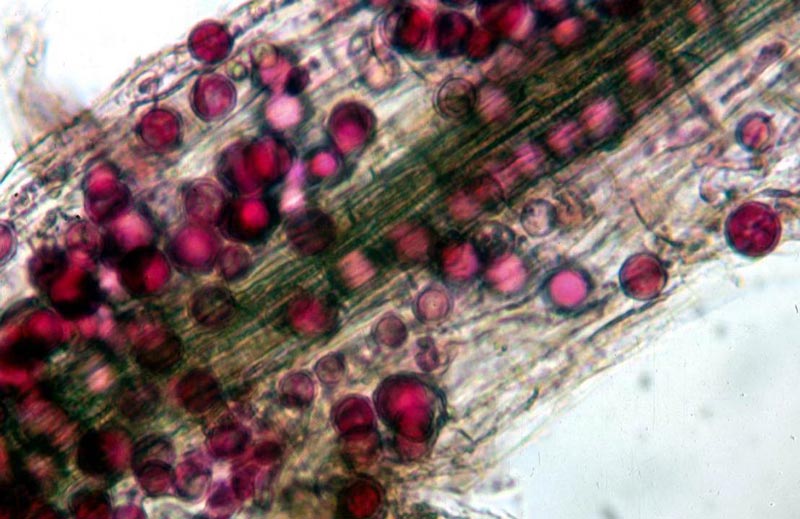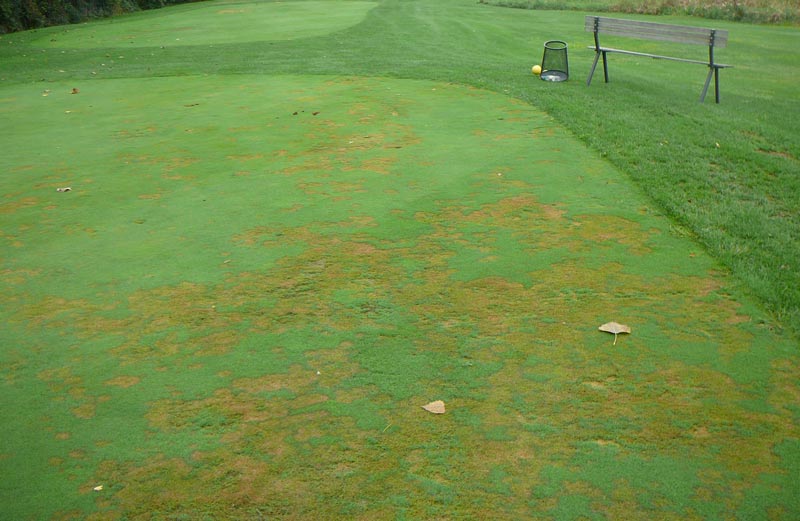
Pythium oospores in plant roots prevent efficient water movement, resulting in weak roots and eventually leading to root death and canopy thinning. Photos courtesy of Bayer
Editor’s note: The following article was supplied by Bayer. All product claims, research cited and other information is directly from the company.
Pythium root rot can be a major problem on cool-season putting greens in the northern tier of the country. It can be caused by more than 30 Pythium root-infecting species, which vary widely by geography.
Symptoms include chlorotic, yellow to orange thinned patches or streaks in drainage areas, commonly observed during periods of extended rainfall and high heat. The disease can plague waterlogged soils in spring or during cool, slow-growth periods.
When is the best time to treat the symptoms of Pythium root rot?
Though most golf course superintendents are concerned about summer symptoms, fungicide applications should be initiated in advance of summer heat, which is when damage is typically seen. For best results, start when 2-inch soil temperatures average 60 degrees F for five consecutive days.
Once symptoms have emerged, a curative solution is unlikely to be very effective. For turf that has a history of Pythium root rot, preventive action should be taken in spring.
What solutions are available?
There are several effective chemistries available to combat Pythium root rot. Alone or in combination, these products can be implemented into a program to help thwart infection early in the year.
- Many superintendents start with spring applications of Banol at 2-3 oz./1,000 square feet (Banol First Program).
- Signature XTRA Stressgard has shown excellent results for Pythium root rot control as well as maximizing plant health.
- The QiI fungicide cyazofamid (FRAC code 21) is a highly effective rotational tool for Pythium control.
- Many QoI fungicides (FRAC code 11) are also effective as part of a season-long program.

Foliar Pythium prevalent in an area with wet soil and limited air movement.
It is important to water-in products targeting Pythium root rot to the depth of the root zone after application. Start with applications in early to mid-spring on three- to four-week intervals until summer heat and stress set in, after which tightening intervals to two weeks is usually recommended, especially in challenging environments or areas with a history of Pythium root rot. Rotating modes of action can help combat resistance to particular chemistries as well as maximize control over the wide range of Pythium species that may be present.
Other than fungicide applications, what else can be done?
An important step in reducing Pythium root rot is keeping the soil profile as dry as feasible while still maintaining adequate playing conditions. Cultural practices that will help include:
- Improvements to internal drainage in problematic areas across the golf course.
- Regular aerification and topdressing.
- Reducing overhead irrigation with hand watering and use of moisture meters.
- Minimizing stress by using rollers to reduce mowing frequency and/or raising the mowing height.
- Scouting/assaying for exacerbating issues. (For example, recent research from the University of Florida strongly suggests that nematodes enhance infection and damage from Pythium root rot.)
If I follow these steps, what response can I expect?
The goal is to condition the turf to be as healthy and robust as possible heading into the difficult summer months. Late or curative intervention during summer heat often results in sluggish, inefficient recovery because of the slow-growing nature of cool-season turfgrass during that time of year. Preventive strategies to improve overall plant health and root development will ultimately allow the plant to tolerate both biotic (Pythium root infection) and abiotic (drought, heat, traffic, saturation, shade, etc.) summer stresses, resulting in:
- Improved root biomass
- More efficient and predictable water use
- Better nutrient uptake and utilization
- Enhanced fungicide/product efficacy
- More consistent playing conditions
For more information on and solutions for Pythium root rot, visit the Bayer Talking Turf blog.
Paul Giordano, Ph.D., is a Bayer Green Solutions Team specialist. He provides technical expertise to golf course turf managers, helps with the transition of new products from development to market, and provides scientific thought, leadership and education to the industry, with a focus on the northeastern United States. Paul has a Ph.D. in plant pathology, a Master of Science in plant pathology, and a Bachelor of Science in crop and soil sciences from Michigan State University.